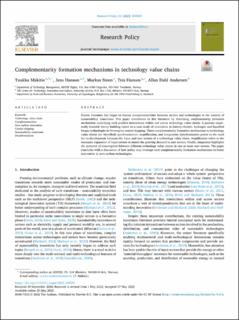| dc.contributor.author | Mäkitie, Tuukka Rainer Reinhold | |
| dc.contributor.author | Hanson, Jens | |
| dc.contributor.author | Steen, Markus | |
| dc.contributor.author | Hansen, Teis | |
| dc.contributor.author | Andersen, Allan Dahl | |
| dc.date.accessioned | 2022-09-15T12:10:16Z | |
| dc.date.available | 2022-09-15T12:10:16Z | |
| dc.date.created | 2022-05-26T09:20:32Z | |
| dc.date.issued | 2022 | |
| dc.identifier.citation | Research Policy. 2022, 51 (7), 104559. | en_US |
| dc.identifier.issn | 0048-7333 | |
| dc.identifier.uri | https://hdl.handle.net/11250/3018074 | |
| dc.description.abstract | Recent literature has begun to discuss complementarities between sectors and technologies in the context of sustainability transitions. This paper contributes to this literature by theorizing complementarity formation mechanisms underlying such positive interactions within and across technology value chains. It pursues empirically founded theory building based on a case study of innovation in battery-electric, hydrogen and liquefied biogas technologies in Norwegian coastal shipping. Three complementarity formation mechanisms in technology value chains are identified: synchronization, amplification, and integration. Synchronization points to the need for co-development between the input and user sectors of a technology value chain. Amplification refers to the necessary expansion of input sectors to match the growing demand in user sectors. Finally, integration highlights the potential of convergence between different technology value chains in one or more user sectors. The paper concludes with a discussion of how policy may leverage such complementarity formation mechanisms to foster innovation in zero‑carbon technologies. | en_US |
| dc.language.iso | eng | en_US |
| dc.publisher | Springer | en_US |
| dc.rights | Navngivelse 4.0 Internasjonal | * |
| dc.rights.uri | http://creativecommons.org/licenses/by/4.0/deed.no | * |
| dc.subject | Technology value chain | en_US |
| dc.subject | Complementarities | en_US |
| dc.subject | Zero‑carbon innovation | en_US |
| dc.subject | Coastal shipping | en_US |
| dc.subject | Sustainability transitions | en_US |
| dc.subject | Decarbonization | en_US |
| dc.title | Complementarity formation mechanisms in technology value chains | en_US |
| dc.title.alternative | Complementarity formation mechanisms in technology value chains | en_US |
| dc.type | Peer reviewed | en_US |
| dc.type | Journal article | en_US |
| dc.description.version | publishedVersion | en_US |
| dc.rights.holder | © 2022 The Authors | en_US |
| dc.source.volume | 51 | en_US |
| dc.source.journal | Research Policy | en_US |
| dc.source.issue | 7 | en_US |
| dc.identifier.doi | 10.1016/j.respol.2022.104559 | |
| dc.identifier.cristin | 2027537 | |
| dc.relation.project | Norges forskningsråd: 268166 | en_US |
| dc.relation.project | Norges forskningsråd: 296205 | en_US |
| dc.relation.project | Norges forskningsråd: 295021 | en_US |
| dc.source.articlenumber | 104559 | en_US |
| cristin.ispublished | true | |
| cristin.fulltext | original | |
| cristin.qualitycode | 2 | |

